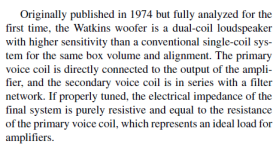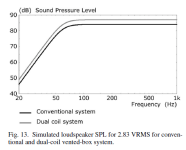Of the 4 or 6* ways of generating the feedback signal that I can think of, they all have in common is 2 things: (1) each has been reliably reported be a truly great improvement and (2) each has its critics. Don't know as I've ever seen a shoot-out comparison and hard to fashion an experiment to compare them apples-to-apples.
B.
* voice coil (or with a Wheatstone bridge)
purpose-built winding
motion sensor (or even with the cheapy Philips piezo-electric)
enclosure sensor
B.
* voice coil (or with a Wheatstone bridge)
purpose-built winding
motion sensor (or even with the cheapy Philips piezo-electric)
enclosure sensor
No doubt that is all true. But as per studies by Geddes, Toole and Welti using three to four subs almost always results in smoother bass response, regardless of how well the room is corrected acoustically-and/or via software, for those like me using digital music sources.
Therefore, perhaps the only practical question regarding comparative subwoofer performance seems to be: Given a mostly empty room (save for thin wall to wall carpeting) that's 20 ft x 13 with a triangular ceiling that slopes from 11 ft to 8, please speculate on degrees of best all around performance among these subwoofer options:
Two pairs of these sealed 12" subs. https://www.rythmikaudio.com/F12SE.html
https://www.rythmikaudio.com/F12SE_specs.html
Two pairs of these open baffle subs. https://gr-research.com/product/sub-series-double-trouble-with-flatpacks-copy/ https://gr-research.com/product/servo-sub-kit-4-7/
Two pairs of each.
Therefore, perhaps the only practical question regarding comparative subwoofer performance seems to be: Given a mostly empty room (save for thin wall to wall carpeting) that's 20 ft x 13 with a triangular ceiling that slopes from 11 ft to 8, please speculate on degrees of best all around performance among these subwoofer options:
Two pairs of these sealed 12" subs. https://www.rythmikaudio.com/F12SE.html
https://www.rythmikaudio.com/F12SE_specs.html
Two pairs of these open baffle subs. https://gr-research.com/product/sub-series-double-trouble-with-flatpacks-copy/ https://gr-research.com/product/servo-sub-kit-4-7/
Two pairs of each.
Only if you use a colour bulb. 😉So, if you wire it with a single voice coil to the amp, then you can wire a lightbulb on the other coil and make a color organ!
If you don´t mind adding horrible crossover distortion, please be my guest 😉Put an LED light bulb.
Filamengt bulbs are lossy (duh!) but at least do not have a 1.9V (or higher) threshold.
The driver’s non-linear performance is very good - a simple search will lead you to this information (..though I discount the little 8” version here - look to 12 & 15 inch drivers).You just described Rythmik's sense coil type "servo". Unfortunately, it's subject to the same motor non-linearities that impact the driving voice coil..
The feedback (dual-coil) driver versions when used with their “servo” amps tend to affect resulting compliance and the back emf range around resonance positively, both with respect to non-linear problems around resonance and issues with added phase/time. The price for this can be added *excursion but like all designs this is dependent on lower freq. level vs. enclosure volume relative to total Sd. (..basically no “free lunch” here, so while you can place the drivers in smaller enclosures and achieve a similar lower freq. response (vs a larger enclosure) you will still suffer power compression limits with the driver working “harder”.)
*which results in increased non-linear effects.
But what if the low frequency level were limited to ~ 25Hz for two 12" Rythmik sealed subs, plus either another two of same OR twoThe price for this can be added *excursion but like all designs this is dependent on lower freq. level vs. enclosure volume relative to total Sd. (..basically no “free lunch” here, so while you can place the drivers in smaller enclosures and achieve a similar lower freq. response (vs a larger enclosure) you will still suffer power compression limits with the driver working “harder”.)
*which results in increased non-linear effects.
of these OB subs https://gr-research.com/product/sub-series-double-trouble-with-flatpacks-copy/ for a total of four subs. Would that "combined" larger Sd and cabinet volume result in effectively higher allowable output (and/or "slam"??) yet reduced driver excursion,
thus less distortion?
Note: Crossing with my midwoofers where their sealed cabinets have them play down to 70Hz. Room is ~ 11 ft x 20 opening across a 3 ft
wide hallway and into a 9 ft x 10 kitchen. Triangular ceiling above everything, sloping from 11 ft down to 8 ft. Three small bay windows on one of the two short walls; normally closed and draped.
Last edited:
LOL !! good oneOnly if you use a colour bulb. 😉
and Drummer... punchline rimshot please
Listeners in that space are just me and sometimes my cat on our small upholstered swivel/rockers. Otherwise, the room, with thin pile carpeting, a a few thicker Karastan remnants, is mostly empty.The price for this can be added *excursion but like all designs this is dependent on lower freq. level vs. enclosure volume relative to total Sd. (..basically no “free lunch” here, so while you can place the drivers in smaller enclosures and achieve a similar lower freq. response (vs a larger enclosure) you will still suffer power compression limits with the driver working “harder”.) *which results in increased non-linear effects.
Depends on the recording. Most of the time you do not want to low-freq. limit the result because doing that limits low-freq. hall sound (real or processed) that depending on the recording gives cues to sound-stage size.But what if the low frequency level were limited to ~ 25Hz for two 12" Rythmik sealed subs, plus either another two of same OR two
of these OB subs https://gr-research.com/product/sub-series-double-trouble-with-flatpacks-copy/ for a total of four subs. Would that "combined" larger Sd and cabinet volume result in effectively higher allowable output (and/or "slam"??) yet reduced driver excursion,
thus less distortion?
Note: Crossing with my midwoofers where their sealed cabinets have them play down to 70Hz. Room is ~ 11 ft x 20 opening across a 3 ft
wide hallway and into a 9 ft x 10 kitchen. Triangular ceiling above everything, sloping from 11 ft down to 8 ft. Three small bay windows on one of the two short walls; normally closed and draped.
Also, more surface area (driver Sd in total) usually reduces “slam” because (all-else-equal) it reduces excursion, and excursion (along with Mms, loudness, and efficiency) tends to generate the physical sensation of “slam”. However this is dependent on the room interaction, so even if your extra subwoofers result in lower excursion they may well be improving/raising a freq. range of suck-out (w/ a single sub.) that results in improved slam.
Monopole subs will be nauseating for those in the kitchen.
Last edited:
As long as you don’t have other rooms nearby with people then you should be OK. But if you do, then remember that most walls will transmit a lot of low-freq. energy (and most doors aren’t sealed enough to do much of anything to block low freq.s).Listeners in that space are just me and sometimes my cat on our small upholstered swivel/rockers. Otherwise, the room, with thin pile carpeting, a a few thicker Karastan remnants, is mostly empty.
Also, more surface area (driver Sd in total) usually reduces “slam” because (all-else-equal) it reduces excursion, and excursion (along with Mms, loudness, and efficiency) tends to generate the physical sensation of “slam”. ..
Well, that's a surprise to hear for those of us who drive Maggies.
..I’ve heard several Maggie’s over the years (if not recently) and I’d never heard much in the way of “slam” from them, though I have heard them actually buckle at higher spl (with massive distortion).
Note that this Is also a common lament with open-baffle sub’s lacking slam and punch. (..it’s why my HT setup that has an open-baffle slot & floor loaded sub ALSO makes use of multiple bass actuators.)
Note that this Is also a common lament with open-baffle sub’s lacking slam and punch. (..it’s why my HT setup that has an open-baffle slot & floor loaded sub ALSO makes use of multiple bass actuators.)
Last edited:
There's also the other possibility - one of the coils may no longer have an electrical connection to the terminals (e.g. if a tinsel lead is broken).I should also mention that if you wire in oarallel but out of phase you should also get near nothing.
dave
In parallel, one coil will be connected to the amp. In series, there will be no coils connected to the amp.
It is a pity indeed, perhaps opening the Watkins Woofer as a new thread. As the authors say, with the properly tuned filter the speaker now represents a purely resistive impedance to the amplifier.
And the authors have the CV to warrant paying attention.
And the authors have the CV to warrant paying attention.
Did you open that thread?
I got a pair of Entec woofers... they use a servo circuit. I don't think they are dual coil, since that would require twice the amplifier power but the concept of using a dual coil to apply compensation to the main coil is quite interesting. I guess self powered woofer systems like the Entecs simply feed back the correction system into the input signal. Given the low frequencies ( long wave periods ) a sufficiently fast correction system is easy enough to concoct.
With a passive dual coil... would the amplifier then see half the load impedance? Assuming that both the mechanical load and the correction load both have the same impedance load ( just spread out over different frequencies ).
Would it be reasonable to dual amp each driver? On first blush, I don't think we'd want to do that for the Watkins Woofer since the main job of the second coil circuit is to "correct" the inductive loads to the amplifier., so the amp must see both loads in parallel.
But on further thought, I'd guess that the correction might be done at the mechanical level proper and dual amplifiers would work as well, so long as they are not affected by the power factor going into the speaker.
I got a pair of Entec woofers... they use a servo circuit. I don't think they are dual coil, since that would require twice the amplifier power but the concept of using a dual coil to apply compensation to the main coil is quite interesting. I guess self powered woofer systems like the Entecs simply feed back the correction system into the input signal. Given the low frequencies ( long wave periods ) a sufficiently fast correction system is easy enough to concoct.
With a passive dual coil... would the amplifier then see half the load impedance? Assuming that both the mechanical load and the correction load both have the same impedance load ( just spread out over different frequencies ).
Would it be reasonable to dual amp each driver? On first blush, I don't think we'd want to do that for the Watkins Woofer since the main job of the second coil circuit is to "correct" the inductive loads to the amplifier., so the amp must see both loads in parallel.
But on further thought, I'd guess that the correction might be done at the mechanical level proper and dual amplifiers would work as well, so long as they are not affected by the power factor going into the speaker.
To my understanding, a dual voicecoil woofer makes it possible to apply a stereo bass signal to the woofer using a stereo amp or a crossover and the stereo signal will be summed electrically to a mono bass output.
- Home
- Loudspeakers
- Subwoofers
- Why would a dual voice coil only work in parallel but not series?


